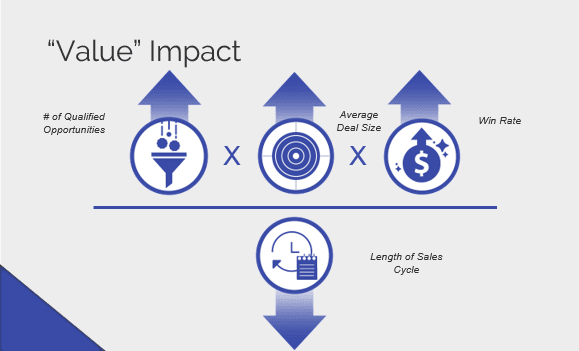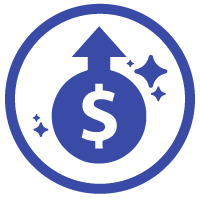Sales velocity is an increasingly popular method for measuring overall B2B sales performance and pipeline health. It’s an equation that generates a number ‑ your sales velocity.
The number doesn’t mean much in absolute terms. You need to compare it relative to other sales velocity figures across groups and over time. If your sales velocity is going down, that’s bad. If it’s going down quickly and fast, as a sales leader, you might want to start looking for another job.

The goal is to make it increase by moving each of the levers in the right direction. The four levers are below:
- Number of Qualified Opportunities
- Average Deal Size
- Win Rate %
- Sales Cycle Length
Sales Velocity Through a Value Lens
Sales velocity is the output of the equation with each of the levers acting as an input. At LeveragePoint we believe a successful value approach impacts all four of these levers simultaneously. If you’re using value throughout your process, your team impacts those levers in a positive direction automatically, helping you increase the number of qualified opportunities in your pipeline, increase price/deal size, improve win rates and shorten sales cycles. Value helps with all of this at once…if you’re doing it correctly.

A good, if imperfect, analogy for how value can impact your sales outcomes is one’s diet. If we are concerned about improving our health, one of the first things a doctor will tell you is to change what you eat. By eating healthier, you’ll be more likely to lose weight, but also improve your sleep, mood and memory, as well as decrease your risk for chronic illnesses like cancer and heart disease, and much more. Changing one thing can have a host of downstream consequences, positive and negative. Using that same analogy when we look at value, we can impact a number of critical sales outcomes by utilizing Value Selling techniques
Let’s look at the specific role value plays for each of these levers, in order to explore the magnitude of impact that Value Selling can have on your B2B organization.
 Increasing Opportunities: When we think about increasing qualified opportunities, the visual that comes to mind is filling the top of your funnel with SQLs. However, if you fill your funnel with a bunch of opportunities that aren’t qualified, you’ll waste a lot of time and resources. As a sales leader, one of the biggest fears I have is my team working opportunities that are never going to close. Unfortunately, many times we don’t know which ones they are until it’s too late.
Increasing Opportunities: When we think about increasing qualified opportunities, the visual that comes to mind is filling the top of your funnel with SQLs. However, if you fill your funnel with a bunch of opportunities that aren’t qualified, you’ll waste a lot of time and resources. As a sales leader, one of the biggest fears I have is my team working opportunities that are never going to close. Unfortunately, many times we don’t know which ones they are until it’s too late.
On average, 60% of the deals in a typical pipeline will never close. This generates frustration during every funnel review. A strong value approach helps qualify those deals early in the sales cycle by quantifying the financial impact that your offering can have on a customer’s business. If you can impact that business by $10,000, they may look at you and say, “well that’s great, but I have projects that can impact it by half a million dollars and your $10k impact is really not that interesting.”
Getting to “no” quickly is important….and of course getting to a “yes” quickly is even more important. It’s the middle that drains the resources of sales organizations and fills the funnel with deals that will never close. I personally remember many meetings, as a young sales guy, that were very product / technology focused and I left feeling confident. I learned later that I was seeking approval. I was excited about the prospect of another meeting. That’s the problem. Just because a meeting goes well – maybe they say a few things that are generally positive – you assume that this deal is qualified. Alternatively, if you focus your conversation on business impact, collaborating and customizing a value-based proposal in the process, you will learn very quickly if this opportunity worth pursuing. Worst case, you will learn what you are offering is not compelling enough, allowing you to focus on deals that can actually close. Increase Average Deal Size: The next lever in the Sales Velocity formula is average deal value, and there a couple of ways that value can impact the revenue generated from a specific deal.
Increase Average Deal Size: The next lever in the Sales Velocity formula is average deal value, and there a couple of ways that value can impact the revenue generated from a specific deal.
According to a Gartner, over 80% of buyers are overwhelmed by the information that they get. Turning this information into a strong internal financial justification is critical to moving a project forward. This is an activity that buyers may do from time to time. In fact, some of your champions may be doing this for the first time. A well-designed value story, once adapted to the current situation, becomes the basis for the business proposal they will ultimately need. This accomplishes a couple things. It helps them justify the investment of course, but it also helps them justify a solution (which may include other products, services or other add-ons). That solution will tend to be larger and more comprehensive.
Secondly, a strong value story provides sellers the confidence to push back on discounting pressure you will almost always receive from procurement. A jointly developed business case should evaluate options, including the “no decision” option and demonstrate why the organization should invest now, and in your solution. A good value story is clear, quantified and makes the financial decision obvious. The greater the value of the proposal, in terms of cost savings and/or revenue increases, the stronger the reason to say “no” to discounts. Improve Win Rates: The third area where value makes a major impact on sales velocity is with win rates. One of the reasons top B2B companies utilize value selling is because it gives their sales teams an advantage when being compared directly to a competitor, an alternative solution that a customer may be maybe looking at, or a do-nothing decision. Being able to directly convey the quantified financial value relative to your competition makes buyer decisions easier and you end up winning many more of those deals than otherwise. According to research by Corporate Visions, the first vendor to introduce value in a sales situation wins the business almost 75% of the time. If you’re the first person to paint a vision, you’ll be in the dominant position, influence the purchaser’s buying criteria, and help guide the sale. This underscores the importance of using value early and throughout the sales process.
Improve Win Rates: The third area where value makes a major impact on sales velocity is with win rates. One of the reasons top B2B companies utilize value selling is because it gives their sales teams an advantage when being compared directly to a competitor, an alternative solution that a customer may be maybe looking at, or a do-nothing decision. Being able to directly convey the quantified financial value relative to your competition makes buyer decisions easier and you end up winning many more of those deals than otherwise. According to research by Corporate Visions, the first vendor to introduce value in a sales situation wins the business almost 75% of the time. If you’re the first person to paint a vision, you’ll be in the dominant position, influence the purchaser’s buying criteria, and help guide the sale. This underscores the importance of using value early and throughout the sales process.
Additionally, it helps transform your salespeople from sellers focusing on features and benefits, to subject matter experts, creating a more consultative selling dynamic and positioning them as credible advisors. Reduce Sales Cycles: Finally, as important as the top-line sales numbers are, the ability to shave weeks and months off of the time it takes to close a deal is critical to maximizing sales velocity and overall revenue. Salespeople who spend most of their time talking about product will end up attracting people in the account that are most comfortable with those type of conversations. You can talk about features, functionality, and technology all day long, but the deal isn’t going anywhere until you get in front of the executives with decision making power.
Reduce Sales Cycles: Finally, as important as the top-line sales numbers are, the ability to shave weeks and months off of the time it takes to close a deal is critical to maximizing sales velocity and overall revenue. Salespeople who spend most of their time talking about product will end up attracting people in the account that are most comfortable with those type of conversations. You can talk about features, functionality, and technology all day long, but the deal isn’t going anywhere until you get in front of the executives with decision making power.
These executives tend to be far less interested in the underlying features, technology, and other factors (they expect the folks that work for them to do that and to vet that out) than they are in hearing the ways it will impact their business, and how you’ve impacted other businesses like them. Sellers need to be able to express this in a quantifiable way in the business terms they understand.
If you’re successful, you’re going to compress your sales cycle because you’re going to make an obvious statement that says, my solution will help you immediately and here’s how much it’s going to help you. You will get the attention of the decision-maker sooner, make the decision for the executive much easier, causing them to move more quickly in your direction.
Increase Sales Velocity with Value Selling
These four levers, when taken together, make up the sales velocity equation. The beauty of this approach is that it becomes quickly obvious that you don’t need to make dramatic improvements in any one of these areas, because improving each input by a few percentage points adds up, and can represent millions of dollars (or more) of increased revenue. Value Selling is the best way to impact all four levers at once. By implementing a Value Selling initiative, and adopting technology that supports it, the impact will be felt in several areas, improving overall Sales Velocity and generating additional revenue for your B2B business.

